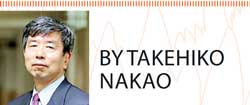25 May 2016 - {{hitsCtrl.values.hits}}

For nearly 50 years, the Asian Development Bank has supported its developing member countries as they strive to close their infrastructure gaps. Building on the progress made over that time, these countries now recognize the importance of adopting higher technical specifications and advanced technology in infrastructure projects. But they are often unaware of the options available and can be deterred by high initial costs.
On recent visits to some Nordic countries, Portugal, Spain and Austria, I had the opportunity to meet with CEOs of companies that use advanced technologies to build bridges, power plants, and water and sewage systems. These companies have been operating for decades in many parts of the world including Asia, investing continuously in technological innovations. I was impressed by their enthusiasm for sharing their knowledge and experience with Asian countries. So, why not learn more from such innovative companies from around the world and involve them in delivering better infrastructure for improved public services in our region?
Stronger planning
There are at least three reasons for designing and executing projects with advanced technologies in developing Asia.
First and foremost is the need to address climate change effectively through mitigation as well as adaptation. Without the use of frontier technologies, the targets set last December at COP 21, delineated in the Paris agreement on climate change, will not be achieved. We need to provide energy for all while cutting carbon dioxide emissions, in line with a U.N.-led initiative. This requires countries to invest more in new and cleaner technologies, including renewable energy, smart grids and energy efficiency. They also need innovative urban transportation solutions, such as integrated multimodal transit systems and electric vehicles.
Second is the demonstration and development impact of projects with advanced technologies. Higher standard infrastructure can help countries move up the quality ladder, establishing models that can be replicated through their own resources. While the ADB is increasing its annual financing capacity by 50% to at least $20 billion by 2020, the needs of developing countries remain far higher. The ADB and other multilateral institutions can maximize development impact by supporting the spread of higher technology.
The third reason, at a more practical level, is the cost incurred over the life cycle of infrastructure assets. The higher initial investment cost of projects with advanced technology often leads countries to opt instead for less expensive lower technology solutions. But these initial savings may be illusory, as they do not account for other costs often quite significant such as maintenance and replacement.
Improved implementation
Through a three-pronged action plan, the ADB will help developing Asia adopt advanced technology.
First, we will strengthen our support for project design to balance cost, quality and sustainability considerations over the life cycle of infrastructure assets. To accelerate this shift, projects with advanced technology or green content will be prioritized for ADB financing.
An example is the recently approved $1 billion India Green Energy Corridor and Grid Strengthening Project, which adopts high-voltage direct current transmission technology to improve efficiency and reduce transmission losses as well as carbon emissions. The Sri Lanka Jaffna Kilinochchi Water Supply and Sanitation Project will install a desalination plant to treat seawater for a potable water supply, using semi-permeable membranes to separate salts from the water. Metro projects in Hanoi and Ho Chi Minh City in Vietnam will result in cleaner, more efficient and integrated urban transport systems. The $1 billion Railway Investment Program in China included installation of braking systems that enhanced energy efficiency and reduced CO2 emissions over the life cycle of the railway.
Second, in procurement arrangements, the ADB will place greater emphasis on the quality of consultants to ensure countries get access to the best expertise in the latest advanced technologies. We will also make increased use of single contractor arrangements, such as turnkey contracts. This makes it easier to maintain a consistent focus on quality, as the same contractor will handle engineering, procurement and construction.
Third, we will provide more expertise on innovative approaches. The region’s middle-income countries can already finance their projects at reasonable cost through financial markets. Unless the ADB can effectively combine finance with knowledge and expertise, we will not add value. The ADB itself must continue to build up solid knowledge and expertise.
For this purpose, I have established seven sector groups such as energy, transport and urban, as well as eight thematic groups such as climate change and public-private partnership within the ADB. These groups will provide leadership in our knowledge work, advise countries, drive innovation in our projects and build partnerships with centers of excellence and other institutions. In addition, our human resources department has recently started an experts pool system to recruit highly specialized talent in such areas as smart grids, railways and water utility management.
Asia accounts for half of the world’s population, one-third of global gross national product and the same share of global emissions. As it is growing rapidly, it could reach half of global GDP and an even higher share of global emissions by 2050.
Asia’s performance matters greatly. It is time for transformative action to build a smarter, more sustainable Asia and Pacific region through more advanced technology. The ADB will play an important role in this effort by partnering with innovative companies and institutions from around the world.
(Takehiko Nakao is president of the Asian Development Bank)
10 Jan 2025 6 minute ago
10 Jan 2025 2 hours ago
10 Jan 2025 3 hours ago
10 Jan 2025 4 hours ago
10 Jan 2025 5 hours ago